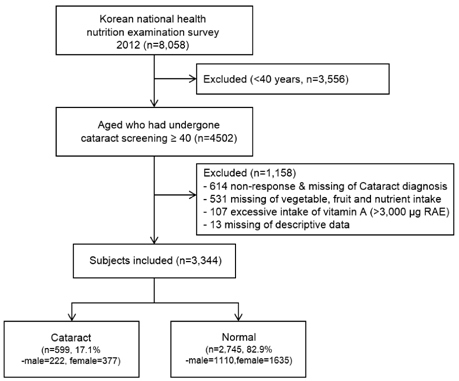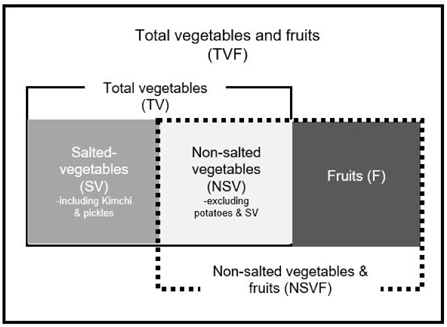J Nutr Health.
2018 Oct;51(5):423-432. 10.4163/jnh.2018.51.5.423.
Intake of fruits and vegetables may modify the risk of cataract in Korean males: data from Korean National Health and Nutrition Examination Survey 2012
- Affiliations
-
- 1Department of Food and Nutrition, Research Institute for Human Ecology, Chonnam National University, Gwangju 61186, Korea. yrhuh@jnu.ac.kr
- 2Department of Food and Nutrition, Keimyung University, Daegu 42601, Korea.
- KMID: 2427765
- DOI: http://doi.org/10.4163/jnh.2018.51.5.423
Abstract
- PURPOSE
Cataract is a major cause of a loss of eye sight, and is a critical health issue in an aging society. The oxidative stresses to the lens due to various exterior/interior stimuli leads to degenerative changes of the visual system, resulting in cataract. Therefore, reducing the level of oxidative damage is critical in the prevention of the disease. This study examined the association between the risk of cataract and intake of fruits and vegetables, the major dietary source of antioxidants.
METHODS
Using the data of Korean National Health and Nutrition Examination Survey 2012, the intake of fruits and vegetables of 1,332 males (222 cases) and 2,012 females (377 cases) were analyzed, taking into account the cataract phenotype. Their dietary intake was categorized in 6 groups: TV (total vegetables), F (fruits), TVF (TV+F), SV (salted vegetables), NSV (Non-SV), and NSVF (NSV+F). The level of intakes were evaluated referring to the recommendation level of various dietary guidelines.
RESULTS
The presence of cataract was associated with some type of fruit and vegetable intake. In males, the controls had more TVF (p < 0.001), TV (p = 0.001), SV (p = 0.012), NSV (p = 0.007), and NSVF (p < 0.001) intake than the cases, and the lower intake of TVF (< 500g), TV (300g), NSV (< 100g), and NSVF (< 400g) increased the risk of cataract by up to 1.7 fold [95% confidence interval: 1.06-2.71]. In females, the controls also had a higher intake of TVF (p < 0.001), TV (p = 0.042), and NSVF (p < 0.001), but the intake of such fruits and vegetables did not predict the meaningful risk of cataract. The intake of SV and F was not associated with the cataract phenotype in either males or females.
CONCLUSION
The intake of fruits and vegetables can modify the risk of cataract in Korean males and a sufficient intake of those could be effective in the prevention of cataract.
MeSH Terms
Figure
Cited by 1 articles
-
The association between dietary sodium intake and the risk of cataract: data from Korean National Health and Nutrition Examination Survey 2012
Jeong-Hwa Choi, Young-Ran Heo
J Nutr Health. 2019;52(3):277-284. doi: 10.4163/jnh.2019.52.3.277.
Reference
-
1. National Eye Institute (US). Prevent Blindness America. Vision problems in the U.S. Prevalence of adult vision impairment and age-related eye disease in America. 2008 update to the fourth edition [Internet]. Chicago (IL): Prevent Blindness America;2008. cited 2018 Aug 8. Available from: http://www.preventblindness.org.2. Korean Institute. Domestic health and welfare news. Health Welf Policy Forum. 2015; (229):93–122.3. Seddon J, Fong D, West SK, Valmadrid CT. Epidemiology of risk factors for age-related cataract. Surv Ophthalmol. 1995; 39(4):323–334.
Article4. Chang JR, Koo E, Agrón E, Hallak J, Clemons T, Azar D, Sperduto RD, Ferris FL 3rd, Chew EY. Age-Related Eye Disease Study Group. Risk factors associated with incident cataracts and cataract surgery in the Age-related Eye Disease Study (AREDS): AREDS report number 32. Ophthalmology. 2011; 118(11):2113–2119.5. McCarty CA, Mukesh BN, Fu CL, Taylor HR. The epidemiology of cataract in Australia. Am J Ophthalmol. 1999; 128(4):446–465.
Article6. Beebe DC. Nuclear cataracts and nutrition: hope for intervention early and late in life. Invest Ophthalmol Vis Sci. 1998; 39(9):1531–1534.7. Theodoropoulou S, Samoli E, Theodossiadis PG, Papathanassiou M, Lagiou A, Lagiou P, Tzonou A. Diet and cataract: a case-control study. Int Ophthalmol. 2014; 34(1):59–68.
Article8. Rautiainen S, Lindblad BE, Morgenstern R, Wolk A. Total antioxidant capacity of the diet and risk of age-related cataract: a population-based prospective cohort of women. JAMA Ophthalmol. 2014; 132(3):247–252.9. Sedaghat F, Ghanavati M, Nezhad Hajian P, Hajishirazi S, Ehteshami M, Rashidkhani B. Nutrient patterns and risk of cataract: a case-control study. Int J Ophthalmol. 2017; 10(4):586–592.
Article10. World Cancer Research Fund. American Institute for Cancer Research. Summary. Food, Nutrition, Physical Activity, and the Prevention of Cancer: a Global Perspective. Washington, D.C.: WCRF/AICR;2007. p. xiv–xxi.11. Ministry of Health and Welfare. The third national health promotion plan (2011-2020) in Korea. Seoul: The Korea Institute for Health and Social Affairs;Institute for Health and Social Affairs.12. Lam D, Rao SK, Ratra V, Liu Y, Mitchell P, King J, Tassignon MJ, Jonas J, Pang CP, Chang DF. Cataract. Nat Rev Dis Primers. 2015; 1(1):15014.
Article13. Babizhayev MA, Deyev AI, Linberg LF. Lipid peroxidation as a possible cause of cataract. Mech Ageing Dev. 1988; 44(1):69–89.
Article14. Bloemendal H, de Jong W, Jaenicke R, Lubsen NH, Slingsby C, Tardieu A. Ageing and vision: structure, stability and function of lens crystallins. Prog Biophys Mol Biol. 2004; 86(3):407–485.
Article15. Palmquist BM, Philipson B, Barr PO. Nuclear cataract and myopia during hyperbaric oxygen therapy. Br J Ophthalmol. 1984; 68(2):113–117.
Article16. Rao LG, Rao AV. Oxidative stress and antioxidants in the risk of osteoporosis: role of the antioxidants lycopene and polyphenols. In : Valdés-Flores M, editor. Topics in Osteoporosis. Rijeka: InTech;2013. p. 117–161.17. Rizvi SI, Pandey KB. Activation of the erythrocyte plasma membrane redox system by resveratrol: a possible mechanism for antioxidant properties. Pharmacol Rep. 2010; 62(4):726–732.
Article18. Ahn S, Jun S, Kang M, Shin S, Wie GA, Baik HW, Joung H. Association between intake of antioxidant vitamins and metabolic syndrome risk among Korean adults. J Nutr Health. 2017; 50(4):313–324.
Article19. Westenhoefer J. Age and gender dependent profile of food choice. Forum Nutr. 2005; (57):44–51.
Article20. Lim H, Kim SY, Wang Y, Lee SJ, Oh K, Sohn CY, Moon YM, Jee SH. Preservation of a traditional Korean dietary pattern and emergence of a fruit and dairy dietary pattern among adults in South Korea: secular transitions in dietary patterns of a prospective study from 1998 to 2010. Nutr Res. 2014; 34(9):760–770.
Article21. Kwon JH, Shim JE, Park MK, Paik HY. Evaluation of fruits and vegetables intake for prevention of chronic disease in Korean adults aged 30 years and over: using the Third Korea National Health and Nutrition Examination Survey (KNHANES III), 2005. Korean J Nutr. 2009; 42(2):146–157.
Article22. Kim EK, Ha AW, Choi EO, Ju SY. Analysis of Kimchi, vegetable and fruit consumption trends among Korean adults: data from the Korea National Health and Nutrition Examination Survey (1998-2012). Nutr Res Pract. 2016; 10(2):188–197.
Article23. Song DY, Park JE, Shim JE, Lee JE. Trends in the major dish groups and food groups contributing to sodium intake in the Korea National Health and Nutrition Examination Survey 1998-2010. Korean J Nutr. 2013; 46(1):72–85.
Article24. Bae JH, Shin DS, Lee SC, Hwang IC. Sodium intake and socioeconomic status as risk factors for development of age-related cataracts: the Korea National Health and Nutrition Examination Survey. PLoS One. 2015; 10(8):e0136218.
Article
- Full Text Links
- Actions
-
Cited
- CITED
-
- Close
- Share
- Similar articles
-
- The association between dietary sodium intake and the risk of cataract: data from Korean National Health and Nutrition Examination Survey 2012
- Vegetable and fruit intake in one person household: The Korean National Health and Nutrition Examination Survey (2010~2012)
- Nutrients Intake and Health Status by Fruits and Vegetables Intake in Adolescents Based on the 2013∼2015 Korean National Health and Nutrition Examination Survey
- Analysis of socio-demographic and dietary factors associated with fruit and vegetable consumption among Korean adolescents: use of data from the 7th and 8th Korea National Health and Nutrition Examination Survey (2016–2019)
- Evaluation of Fruits and Vegetables Intake for Prevention of Chronic Disease in Korean Adults Aged 30 Years and Over: Using the Third Korea National Health and Nutrition Examination Survey (KNHANES III), 2005



